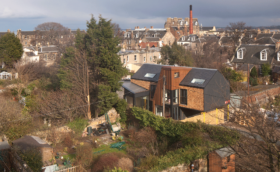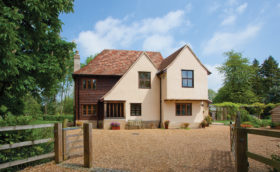
Learn from the experts with our online training course!
Use the code BUILD for 20% off
Learn from the experts with our online training course!
Use the code BUILD for 20% offAndrew and Jan Holden had renovated many properties over the years but when they found a 10-acre smallholding that included a semi-derelict bungalow together with a collection of rundown greenhouses, they knew that they has a great self-build opportunity.
The place had been empty for the past five years so it was overrun with brambles and other invasive plants. However, as soon as the couple saw the location they fell in love with it. “We are seasoned renovators, so we know that the golden rule is never to fall in love with a project until you know all the background information,” says Andrew. “But we couldn’t help it – the plot was just full of possibilities. We had just finished renovating a 16th-century grade II listed chocolate box cottage, and initially wanted to have a rest – but the opportunity was too good to pass up.”
As the existing property was a small bungalow, the size of its potential replacement proved a point of contention with their local planning department. The plot was situated outside the boundaries of the village, and very close to the edge of a National Park, so special regulations applied.
Andrew took on the mantle of project manager and got the whole family involved in the scheme, including the labouring, carpentry and decorating. “As we have renovated before, we know a lot of good local trades, so getting labour was easy,” he says. “We didn’t use a main contractor and organised everything ourselves. Our trades were great to work with and we only had a few minor problems.”
All utilities were already on site, so only had to be upgraded, but the foundations proved to be rather difficult due to the heavy clay earth. “The soil conditions were terrible,” says Andrew. “We used strip foundations, which were the more cost-effective option, but were very close to having to use piles – which would have cost a fortune.”
Downstairs, the main spaces are the kitchen, hallway with dining zone and lounge. “This suits our needs perfectly as we don’t use a separate dining room often enough to warrant it, and with laptop and tablet technology, who needs an office?” says Andrew. However, there is certainly no lack of leisure space – the couple built a separate 60m2 structure next to their swimming pool, which incorporates Andrew’s den, a gym and shower room.
Upstairs the Holdens have four bedrooms, a shower room and a bathroom. “We went for underfloor heating (UFH) downstairs, but decided to fit radiators upstairs,” says Jan. “We preferred the comfort of a carpet and were also concerned that with the open plan layout downstairs it might get too warm upstairs. As it’s turned out we have most of the radiators turned off, even in winter, as the house is so toasty.”
To be as eco-friendly as possible, the Holdens have a NIBE air source heat pump, which feeds the UFH and the domestic hot water and also heats the pool. On the stable block roof, they also have an array of 16 solar photovoltaic (PV) panels. “We try to run all our utilities during the day to consume as much of our site-generated electricity as possible. We’ve also installed low energy LED light bulbs throughout the property,” says Andrew.
The couple decided not to put in a utility room, opting instead for the American idea of putting a washing machine and tumble-dryer upstairs. “We have a product that’s extremely efficient and only uses 20% of the electricity a regular dryer takes,” says Jan. “In the kitchen we have fitted a Quooker hot water tap, but other than that we didn’t go for too many gadgets and gizmos.”
One of Jan’s favourite features is the sparkling mica wallpaper, used as a feature wall in the dining hall. “Everyone who comes in wants to feel it. It gives a stunning effect and was surprisingly straightforward for us to hang ourselves,” says Jan. “The crystal chandelier was the one real indulgence – we all need a little bling in our lives! I am told the best way to clean it is to spray it with a solution of washing-up liquid and water and leave it to drip-dry overnight.”
“The best part of the self-build process has been the result – the creation of a gorgeous property that looks as if has been sitting in its environment forever,” says Jan. “Many people, some of them builders, think that it’s actually an old house that we’ve refurbished, which is the ultimate accolade.
“The process utilised all the family, who all had some input into it; this kept arguments at a very shallow level, such as what colour or brand to go for,” she adds.
“The worst point is that the build seemed to go on for an eternity and we were so impatient to get in and enjoy the fruits of our labour,” says Andrew. “Although the self-build process is hard, the end results make it more than worthwhile.”
Having created their perfect house, the couple don’t seem too tempted to repeat the winning formula elsewhere. “Why would we want to build again when we have this amazing home?” says Andrew. “However, never say never. If we did it again we might be swayed by the turnkey option and hand the whole build over to Border Oak. If we’d had done that this time, I may have kept a little more of my hair − but it wouldn’t be as satisfying.”
Published: Build It August 2014

